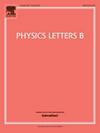无限空间的量子虫洞
IF 4.5
2区 物理与天体物理
Q1 ASTRONOMY & ASTROPHYSICS
引用次数: 0
摘要
我们得出了一个有趣的结果,即经典地由爱因斯坦-罗森桥连接的两个渐近平坦的宇宙也可能在其遥远的区域以量子力学方式连接。这将被远离黑/白洞系统的牛顿势所感知,并提高了通过扰动建立通信的可能性。我们利用质量方差较小的波包,求解了由最大对称简化正则量子化方法导出的方程,得到了我们的结果。质量和牛顿势的代理表现为标准对偶,导致两者之间的海森堡不确定关系。然后建立相干状态,它只在两个区域变得非半经典:渐近空间无穷大(在这里,统一性迫使数据包“感觉”到另一个渐近空间无穷大),以及在r=Gm的视界内,那里有振铃。虽然后者已经在文献中被注意到,但前者——空间无限中的量子虫洞——似乎已经躲过了过去的审查。即使在相干状态下,也有一个自由参数决定了状态变为非半经典的距离,考虑到定义正交和压缩的模糊性,偏离最终成为一阶并切断牛顿势。需要进一步的研究来检验这些结论在其对称性减少的试管之外的稳定性。本文章由计算机程序翻译,如有差异,请以英文原文为准。
Quantum wormholes at spatial infinity
We derive the interesting result that the two asymptotically flat Universes classically linked by the Einstein-Rosen bridge may also be quantum mechanically connected in their far out regions. This would be felt by the Newtonian potential far away from a black/white hole system, and raises the possibility of establishing communication via perturbations. We obtain our results by means of wavepackets with a small variance in the mass, solving the equations derived from a maximally symmetry-reduced canonical quantisation method. Mass and a proxy of the Newtonian potential appear as canonical duals, leading to a Heisenberg uncertainty relation between the two. Coherent states are then built, which become non-semiclassical only in two regions: asymptotic spatial infinity (where unitarity forces the packets to “feel” the other asymptotic spatial infinity), and inside the horizon at where there is ringing. Whilst the latter has been noted in the literature, the former—the quantum wormhole at spatial infinity—seems to have eluded past scrutiny. Even under a coherent state there is a free parameter determining the distance beyond which the states becomes non-semiclassical, given the ambiguity in defining quadratures and squeezing, with departures eventually becoming of order one and cutting off the Newtonian potential. Further studies are required to examine the stability of these conclusions beyond their symmetry-reduced test tube.
求助全文
通过发布文献求助,成功后即可免费获取论文全文。
去求助
来源期刊

Physics Letters B
物理-物理:综合
CiteScore
9.10
自引率
6.80%
发文量
647
审稿时长
3 months
期刊介绍:
Physics Letters B ensures the rapid publication of important new results in particle physics, nuclear physics and cosmology. Specialized editors are responsible for contributions in experimental nuclear physics, theoretical nuclear physics, experimental high-energy physics, theoretical high-energy physics, and astrophysics.
 求助内容:
求助内容: 应助结果提醒方式:
应助结果提醒方式:


